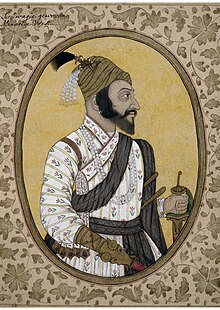| Shivaji I | |
|---|---|
| Raja Shakakarta[1] Haindava Dharmoddharak[2] Kshatriya Kulavantas[3][4] | |
 Portrait of Shivaji (c. 1680s), British Museum | |
| Chhatrapati of the Marathas | |
| Reign | 6 June 1674 – 3 April 1680 |
| Coronation |
|
| Predecessor | Position established |
| Successor | Sambhaji |
| Born | 19 February 1630 Shivneri Fort, Ahmadnagar Sultanate (present-day Maharashtra, India) |
| Died | 3 April 1680 (aged 50) Raigad Fort, Mahad, Maratha Kingdom (present-day Maharashtra, India) |
| Spouse | |
| Issue | 8,[6] including Sambhaji and Rajaram I |
| House | Bhonsale |
| Father | Shahaji |
| Mother | Jijabai |
| Religion | Hinduism |
| Signature | |
Shivaji I (Shivaji Shahaji Bhonsale, Marathi pronunciation: [ʃiˈʋaːdʑiː ˈbʱos(ə)le]; c. 19 February 1630 – 3 April 1680)[7] was an Indian ruler and a member of the Bhonsle dynasty.[8] Shivaji carved out his own independent kingdom from the Sultanate of Bijapur that formed the genesis of the Maratha Confederacy.
Over the course of his life, Shivaji engaged in both alliances and hostilities with the Mughal Empire, the Sultanate of Golconda, the Sultanate of Bijapur and the European colonial powers. Shivaji offered passage and his service to Aurangzeb to invade the declining Sultanate of Bijapur. After Aurangzeb's departure for the north due to a war of succession, Shivaji conquered territories ceded by Bijapur in the name of the Mughals.[9] : 63 Following the Battle of Purandar, Shivaji entered into vassalage with the Mughal empire, assuming the role of a Mughal chief and was conferred with the title of Raja by Aurangzeb.[10] He undertook military expeditions on behalf of the Mughal empire for a brief duration.[11]
In 1674, Shivaji was coronated as the king despite opposition from local Brahmins.[9] : 87 [12] Praised for his chivalrous treatment of women,[13] Shivaji employed people of all castes and religions, including Muslims[14] and Europeans, in his administration and armed forces.[15] Shivaji's military forces expanded the Maratha sphere of influence, capturing and building forts, and forming a Maratha navy.
Shivaji's legacy was revived by Jyotirao Phule about two centuries after his death. Later on, he came to be glorified by Indian nationalists such as Bal Gangadhar Tilak, and appropriated by Hindutva activists.[16][17][18][19][20]
- ^ Sardesai 1957, p. 222.
- ^ Satish Chandra (1982). Medieval India: Society, the Jagirdari Crisis, and the Village. Macmillan. p. 140. ISBN 978-0-333-90396-4.
- ^ H. S. Sardesai (2002). Shivaji, the Great Maratha. Cosmo Publications. p. 431. ISBN 978-81-7755-286-7.
- ^ Narayan H. Kulkarnee (1975). Chhatrapati Shivaji, Architect of Freedom: An Anthology. Chhatrapati Shivaji Smarak Samiti.
- ^ Sarkar, Shivaji and His Times 1920, p. 260.
- ^ James Laine (1996). Anne Feldhaus (ed.). Images of women in Maharashtrian literature and religion. Albany: State University of New York Press. p. 183. ISBN 978-0-7914-2837-5.
- ^ Dates are given according to the Julian calendar, see Mohan Apte, Porag Mahajani, M. N. Vahia. Possible errors in historical dates: Error in correction from Julian to Gregorian Calendars.
- ^ Robb 2011, pp. 103–104.
- ^ a b Cite error: The named reference
Gordon2007was invoked but never defined (see the help page). - ^ Eraly, A. (2007). Emperors Of The Peacock Throne: The Saga of the Great Moghuls. Penguin Books Limited. p. 672. ISBN 978-93-5118-093-7. Retrieved 27 October 2024.
- ^ Richards, John F. (1993). The Mughal Empire. Cambridge University Press. p. 210. ISBN 978-0-521-56603-2.
- ^ Mahaley, K.L. (1969). Shivaji, the Pragmatist. Vishwa Bharati Prakashan. p. 116. Retrieved 18 October 2024.
- ^ Sarkar, Jadunath (1920). Shivaji and his times. University of California Libraries. London, New York, Longmans, Green and co. pp. 20–30, 43, 437, 158, 163.
- ^ Deshpande 2015.
- ^ Scammell, G. (1992). European Exiles, Renegades and Outlaws and the Maritime Economy of Asia c. 1500–1750. Modern Asian Studies, 26(4), 641–661. doi:10.1017/S0026749X00010003, [1]
- ^ Śinde, J.R. (1985). Dynamics of Cultural Revolution: 19th Century Maharashtra. Ajanta Publications. p. 67. Retrieved 12 October 2024.
Shivaji had almost vanished from the minds of the people and the leaders of Maharashtra it was Phule who first revived them composing a ballad on Shivaji in 1869
- ^ Devare, A. (2013). History and the Making of a Modern Hindu Self. Taylor & Francis. p. 157. ISBN 978-1-136-19707-9. Retrieved 12 October 2024.
- ^ Wolpert 1962, pp. 79–81.
- ^ Biswas, Debajyoti; Ryan, John Charles (2021). Nationalism in India: Texts and Contexts. Routledge. p. 32. ISBN 978-1-00-045282-2.
- ^ Sengar, Bina; McMillin, Laurie Hovell (2019). Spaces and Places in Western India: Formations and Delineations. Taylor & Francis. ISBN 978-1-000-69155-9.